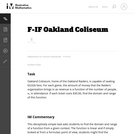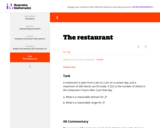
This resource was created by the Washington Office of Superintendent of Public Instruction.
- Subject:
- Mathematics
- Material Type:
- Assessment
- Homework/Assignment
- Author:
- Hannah Hynes-Petty
- Date Added:
- 05/14/2020

This resource was created by the Washington Office of Superintendent of Public Instruction.

The primary purpose of this task is to illustrate that the domain of a function is a property of the function in a specific context and not a property of the formula that represents the function. Similarly, the range of a function arises from the domain by applying the function rule to the input values in the domain. A second purpose would be to illicit and clarify a common misconception, that the domain and range are properties of the formula that represent a function.

In this activity, students explore phase change at a molecular level. They trace the path of an atom to view intermolecular interactions and investigate how temperature relates to phase change. Upon activity completion, students will be able to give examples of phase change, explain how the input of energy into a system affects the state of matter, and describe how both latent heat and evaporative cooling play a role in changes of phase.

This task requires students to use functions to calculate how to best benefit from a pizza promotion.

This lesson unit is intended to help teachers assess how well students are able to translate between graphs and algebraic representations of polynomials. In particular, this unit aims to help you identify and assist students who have difficulties in: recognizing the connection between the zeros of polynomials when suitable factorizations are available, and graphs of the functions defined by polynomials; and recognizing the connection between transformations of the graphs and transformations of the functions obtained by replacing f(x) by f(x + k), f(x) + k, -f(x), f(-x).

The purpose of this task is to get students thinking about the domain and range of a function representing a particular context. Often when a function is being used to model a context, the expression for the function has a larger domain and range than is reasonable for the context. Asking students to focus on a function for which there is no formula focuses attention on the context itself. Note that in many contexts, there are multiple plausible sets that one could choose for the domain (and/or the range), and the solution to the current task provides such an example.